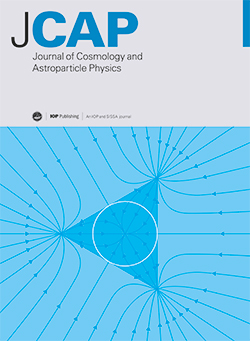Gravitational waveforms from periodic orbits around a quantum-corrected black hole
IF 5.3
2区 物理与天体物理
Q1 ASTRONOMY & ASTROPHYSICS
Journal of Cosmology and Astroparticle Physics
Pub Date : 2025-01-21
DOI:10.1088/1475-7516/2025/01/091
引用次数: 0
Abstract
Extreme mass-ratio inspirals are crucial sources for future space-based gravitational wave detections. Gravitational waveforms emitted by extreme mass-ratio inspirals are closely related to the orbital dynamics of small celestial objects, which vary with the underlying spacetime geometry. Despite the tremendous success of general relativity, there are unsolved issues such as singularities in both black holes and cosmology. Loop quantum gravity, a theory addressing these singularity problems, offers a framework for regular black holes. In this paper, we focus on periodic orbits of a small celestial object around a supermassive quantum-corrected black hole in loop quantum gravity and compute the corresponding gravitational waveforms. We view the small celestial object as a massive test particle and obtain its four-velocity and effective potential. We explore the effects of quantum corrections on marginally bound orbits, innermost stable circular orbits, and other periodic orbits. Using the numerical kludge scheme, we further explore the gravitational waveforms of the small celestial object along different periodic orbits. The waveforms exhibit distinct zoom and whirl phases in a complete orbital period, closely tied to the quantum parameter α̂. We also perform a spectral analysis of the gravitational waves from these periodic orbits and assess their detectability. With the steady progress of space-based gravitational wave detection programs, our findings will contribute to utilizing extreme mass-ratio inspirals to test and understand the properties of quantum-corrected black holes.量子修正黑洞周期轨道的引力波
极端质量比吸气是未来天基引力波探测的关键来源。极端质量比吸气发出的引力波与小天体的轨道动力学密切相关,其随潜在的时空几何形状而变化。尽管广义相对论取得了巨大的成功,但黑洞和宇宙学中的奇点等问题仍未得到解决。圈量子引力是一种解决这些奇点问题的理论,它为常规黑洞提供了一个框架。本文研究了环量子引力中一个小天体绕一个超大质量量子修正黑洞的周期轨道,并计算了相应的引力波形。我们把这个小天体看作一个大质量的测试粒子,得到了它的四速和有效势。我们探讨了量子修正对边缘束缚轨道、最内层稳定圆轨道和其他周期轨道的影响。利用数值组合格式,我们进一步探索了小天体沿不同周期轨道的重力波形。波形在一个完整的轨道周期内表现出明显的缩放和旋转相位,与量子参数α α密切相关。我们还对来自这些周期轨道的引力波进行了光谱分析,并评估了它们的可探测性。随着天基引力波探测项目的稳步推进,我们的发现将有助于利用极端质量比吸气来测试和理解量子校正黑洞的特性。
本文章由计算机程序翻译,如有差异,请以英文原文为准。
求助全文
约1分钟内获得全文
求助全文
来源期刊

Journal of Cosmology and Astroparticle Physics
地学天文-天文与天体物理
CiteScore
10.20
自引率
23.40%
发文量
632
审稿时长
1 months
期刊介绍:
Journal of Cosmology and Astroparticle Physics (JCAP) encompasses theoretical, observational and experimental areas as well as computation and simulation. The journal covers the latest developments in the theory of all fundamental interactions and their cosmological implications (e.g. M-theory and cosmology, brane cosmology). JCAP''s coverage also includes topics such as formation, dynamics and clustering of galaxies, pre-galactic star formation, x-ray astronomy, radio astronomy, gravitational lensing, active galactic nuclei, intergalactic and interstellar matter.
 求助内容:
求助内容: 应助结果提醒方式:
应助结果提醒方式:


